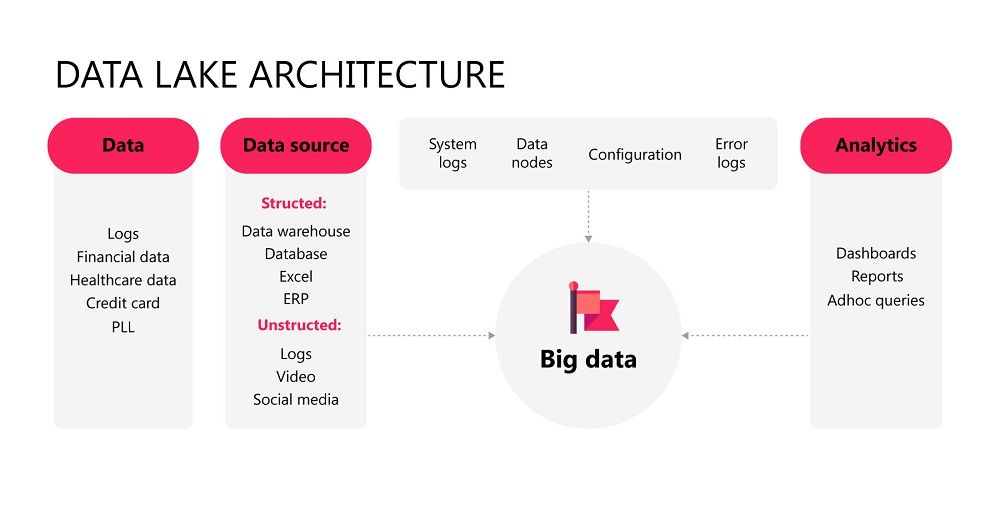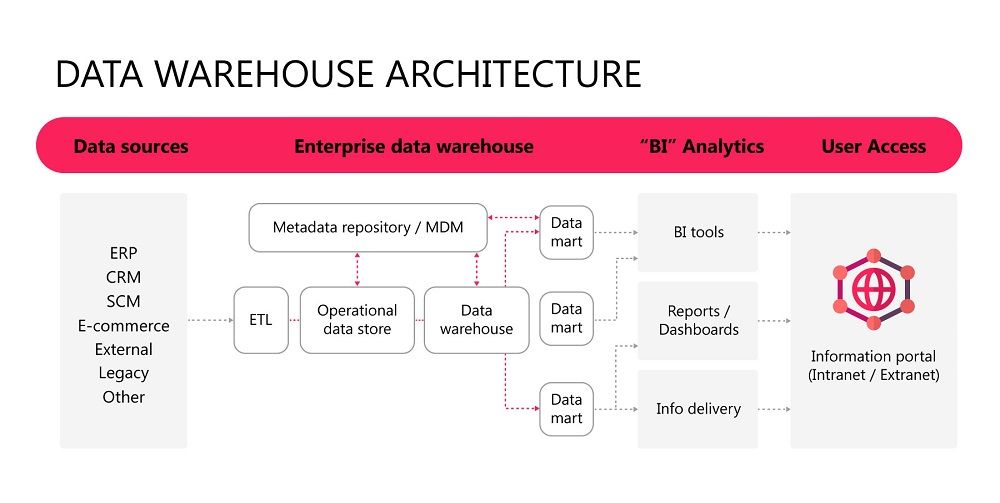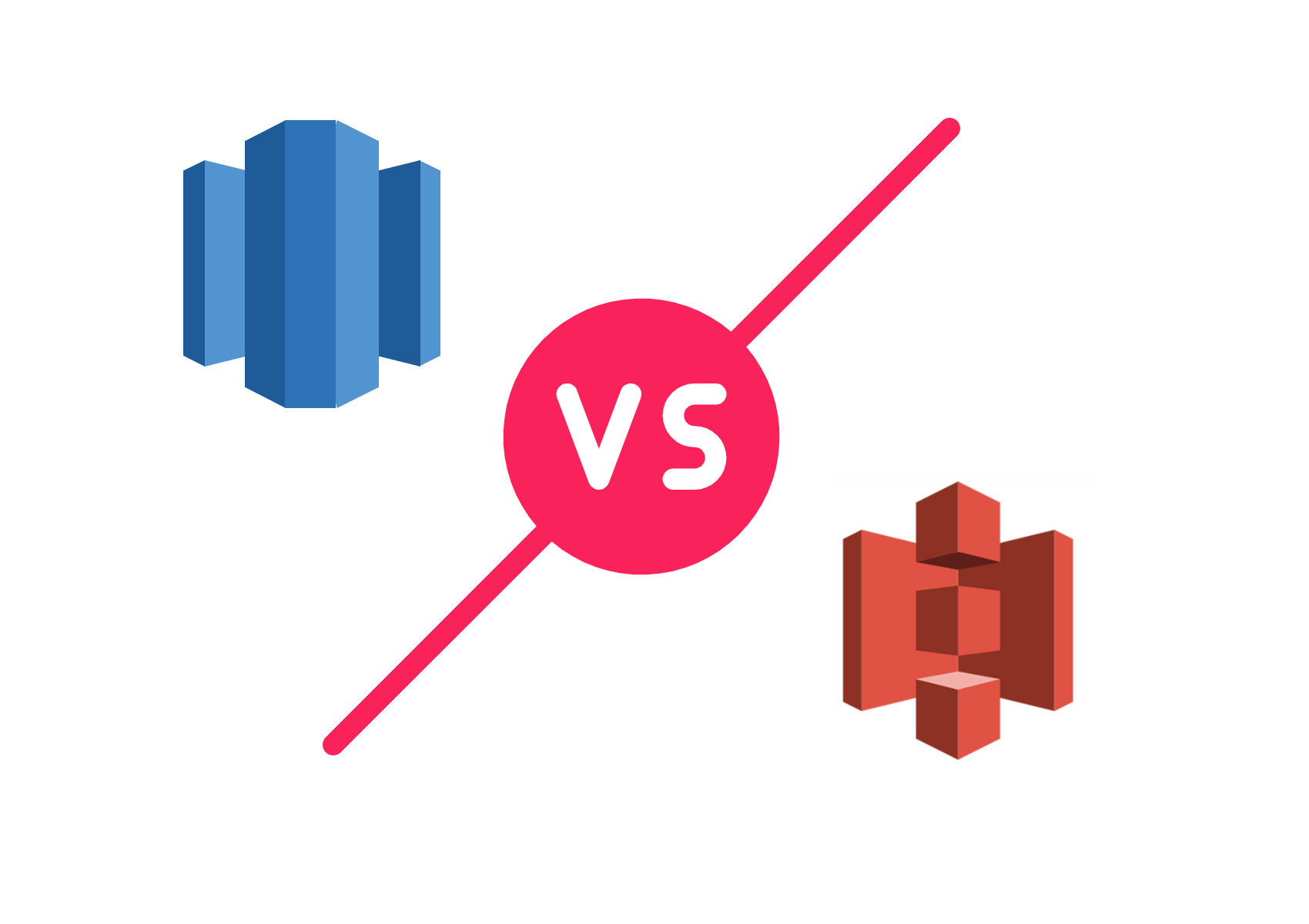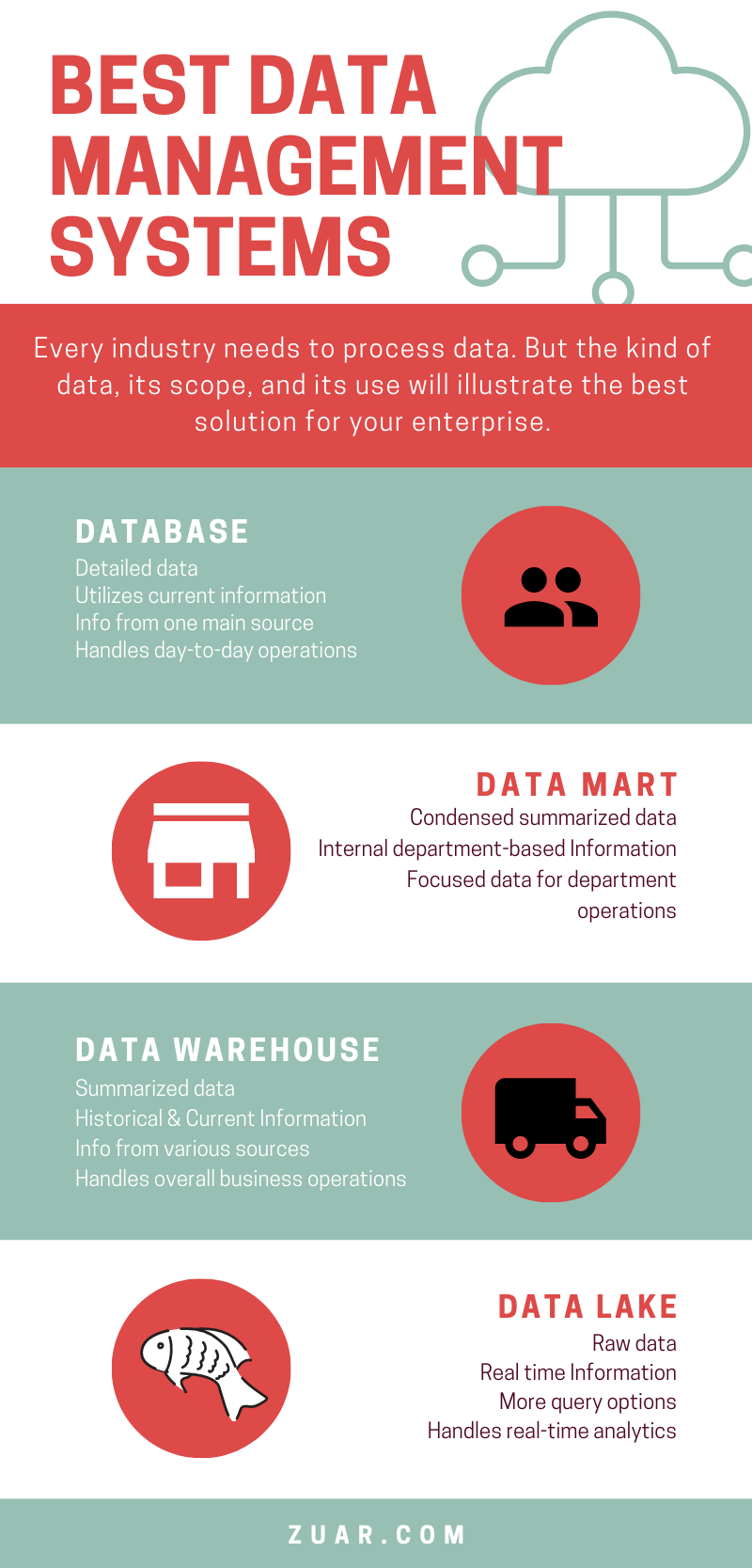What Is The Difference Between A Data Warehouse And A Data Mart
Information Mart vs Data Warehouse vs Database vs Information Lake
Not sure whether to invest in a information mart, information warehouse, database or information lake? Permit's examine the key differences.

Every industry needs to procedure data. Just the kind of data, scope, and utilize will illustrate if a information mart, data warehouse, database, or data lake will exist the best solution for your enterprise.

To get the all-time outcomes, information technology is disquisitional that companies select the best enterprise information direction system to fit their needs. But which is meliorate for your use cases? Is it more advantageous to use a information mart vs. a data warehouse? Or would it be better to use a data mart vs. data lake?
At Zuar, nosotros provide data pipeline strategy and staging services to aid make businesses smarter and more than efficient. And so we've worked extensively with all four of these common types of data management systems. You can learn more near our data services here.
What is a Database?
A database is a storage location of related data used to capture a specific situation. Ane example of a database is a point-of-sale (POS) database. The POS database will capture and shop all the relevant data surrounding a retail store'southward transactions.
Databases have a variety of flavors: structured, relational, relational database direction systems (RDBMS), or unstructured data structures(known as 'NoSQL'). New data coming into the database is processed, organized, managed, updated and and so stored in tables.
Databases are single-purpose repositories of raw transactional information. Because a database is closely tied with transactions, a database performs online transactional processing (OLTP).
Main Characteristics of Databases
- Structured according to company operations and applications
- Rigid rules prepare around data storage/arrangement (RDBMS-specific)
- Flexible information storage (NoSQL-specific)
- Single-purpose in its nature: handles 1 process (due east.yard., POS)
- Utilized for online transaction processing (OLTP)
- Data recording capabilities, capturing transactions as they occur and housing those transactions
What is a Data Warehouse?
A information warehouse is the core analytics system of an organization. The data warehouse will frequently piece of work in conjunction with an operational data store (ODS) to 'warehouse' data captured by the various databases used by the business organisation. For case, suppose a company has databases supporting POS, online activity, customer information, and HR data. In that case, the data warehouse volition have the data from these sources and make them bachelor in a single location. Once again, the ODS volition typically handle the process of cleaning and normalizing the information, preparing it for storage in the information warehouse.
The method of extracting data from the database, transforming information technology in the ODS, and loading it into the data warehouse is an example of the excerpt-transform-load (ETL) process, or the similar ELT process.
Because a data warehouse captures transformed (i.e. cleaned) historical data, it is an platonic tool for information assay. Because business units volition leverage the warehouse information to create reports and perform information analysis, business organization units are frequently involved in how the information is organized. Similar a relational database, it typically uses SQL to query the information, and it uses tables, indexes, keys, views, and data types for data organization and integrity.
While a database can exist a pseudo-information warehouse through the implementation of views, it is considered best practice to use a data warehouse for concern user interaction leaving databases to capture transactional information. Because the principal intent is analytics, a data warehouse is used for online analytical processing (OLAP). OLAP is really Zuar's bread and butter, with our Mitto solution making it possible for companies to automate their ETL/ELT processes.
Main Characteristics of a Data Warehouse
- Stores big quantities of historical data and then old data is not erased when new information is updated
- Captures data from multiple, disparate databases
- Works with ODS to house normalized, cleaned data
- Organized by subject field
- OLAP (online analytical processing) application
- The primary data source for data analytics
- Reports and dashboards use data from data warehouses
The Types of Modern Databases | Zuar
Are y'all running a digital content direction organisation or treatment configurationdata? Peradventure storing data from IoT devices or transaction information or recording inventory? Or are you dealing with any other organization that generatesdata or handles data? If any of your data needs to exist accessed and st…

What is a Information Mart?
A data mart is very similar to a data warehouse. Like a information warehouse, the information mart volition maintain and house cleaned information fix for analysis. All the same, unlike a information warehouse, the scope of visibility is express.
A information mart supplies bailiwick-oriented information necessary to support a specific business unit. For example, a data mart could be created to support reporting and analysis for the marketing department. By limiting the data to a particular business concern unit (for example, the marketing department), the business unit does non have to sift through irrelevant data.
Another do good is security. Limiting the visibility of non-essential information to the section eliminates the chance of that data being used irresponsibly.
A third benefit is speed. As there volition be less data in the data mart, the processing overhead is decreased. This means that queries will run faster.
Finally, considering the data in the data mart is aggregated and prepared for that department appropriately, the chance of misusing the data is reduced. The potential for conflicting reporting is too reduced.
Master Characteristics of a Data Mart
- Focuses on 1 bailiwick affair or business unit
- Acts equally a mini-data warehouse, holding aggregated data
- Data is limited in telescopic
- Often uses a star schema or similar construction
- Reports and dashboards use the information from the data mart
Snowflake vs Redshift vs BigQuery: Comparisons & How to Cull | Zuar
Unsure which data warehouse is all-time for your organization? We compare different aspects of Snowflake, Amazon Redshift, and Google BigQuery.

What is a Information Lake?
A data lake stores an organization'due south raw and processed (unstructured and structured) data at both big and small scales. Unlike a data warehouse or database, a data lake captures annihilation the arrangement deems valuable for hereafter use. This tin be images, videos, PDFs, anything! The information lake will excerpt data from multiple disparate data sources and process the information similar a data warehouse. Too, similar a data warehouse, a data lake can be used for information analytics and report creation. Notwithstanding, the technology used in a data lake is much more circuitous than in a information warehouse.
Different applications and technologies, such every bit Coffee, are used for its processing and analysis. Frequently, data lakes are used in conjunction with motorcar learning. The output from machine learning tests is also often stored also in the data lake. Because of the level of complication and skill required to leverage, a data lake requires users who are experienced in programming languages and information science techniques. Lastly, dissimilar a data warehouse, a information lake does not leverage an ODS for data cleaning.
Master Characteristics of a Data Lake
- Collects all data from many disparate data sources over an extended menses
- Meets the needs of various users in the organization
- It is uploaded without an established methodology
- Processes and cleans data and stores information technology in the data lake
How Are Data Lakes Utilized?
A data lake is an first-class complementary tool to a data warehouse because information technology provides more query options. A information warehouse volition provide structured and organized data. Even so, with the addition of a data lake, the organisation tin can tap into raw data that may offer even more insight or support because data lakes provide real-fourth dimension analytics.
Data marts and data lakes create two sides of the spectrum, where data marts are focused data, and data lakes are enormous repositories of raw data.
The enquiry and science fields depend heavily on data lake architecture.. Information lakes are suitable for scientific apply considering not only is the data raw from feedback sources and algorithms; it'due south also real-time. Science is only as adept as its almost current and relevant deductions. Enquiry needs to be fresh to have an impact on the reports or findings that information technology produces.
In enterprise, information marts are mainly used internally for department-based information. Since it'due south condensed and summarized, data mart information derived from the broader data warehouse allows each department to access more focused data to its operations.
Information Lake Architecture
This model provides a typical use of a data lake. The information lake represents an all-in-one process. The data lake represents an all-in-one procedure. Data comes from disparate sources (databases, various raw data from images, etc.). The information lake process is circular. The ETL process is performed in the data lake, and the cleaned data is and then stored inside the data lake. The cleaned data sets become the source for reports and dashboards.

Database, Data Warehouse & Data Mart Compages
This model provides a view of how the database, data warehouse, and information mart work together. The databases each correspond a unmarried transactional source. An ETL process is performed, preparing the data to send to the operational data store (ODS). The ODS processes the data for the data warehouse. From the data warehouse, subject-specific, express data sets are fed to the diverse data marts. Finally, from the data marts, reports and dashboards are created. While the diagram does not bear witness it, reports and dashboards can be made direct from the data warehouse too.

Information Warehouse vs. Databases
The main difference between these two include:
- Data warehouses shop summarized information while databases utilise detailed data.
- Databases capture transactions, unlike information warehouses, which are used to analyze data.
- Databases business firm current data merely the warehouses business firm both historical and current information.
- Databases capture data from one master source, while data warehouses provide information from various sources.
- In conjunction with reporting and analytics tools, a data warehouse provides insight into the company'due south overall concern operations while a database captures fundamental day-to-day operations.
Data Mart vs. Data Warehouse
The key differences between a data mart vs. a data warehouse include:
- Data marts are smaller, subject-specific subsets of data extracted from a data warehouse.
- Data marts are a repository of essential information for a specific subgroup. Only a few users accept access to the unabridged data warehouse.
- Data marts require less overhead and tin can analyze data faster considering they are smaller subsets of the data warehouse.
- A data warehouse is significantly larger, by and large a terabyte or more than in size, where a data mart is commonly less than 100 GB.
- Data warehouses comprise all the cleaned, normalized data across the business units of an arrangement where a data mart has a smaller scope, typically focused on one line of business organization.
- A data warehouse gets its information from databases; a data mart gets its information from the information warehouse.
Data Lake vs. Data Mart
The cardinal differences between a data lake vs. a data mart include:
- Data lakes incorporate all the raw, unfiltered data from an enterprise where a data mart is a small subset of filtered, structured essential information for a department or function.
- Data marts are very specific, allowing for fast, effective analytics of relevant summarized information. Data lakes are ameliorate for broader, deep analysis of raw information.
- Data lakes are more an all-in-one solution, acting as a data warehouse, database, and information mart. A data mart is a unmarried-use solution and does not perform any data ETL.
- Data lakes accept a primal annal where data marts can be stored in different user areas.
Data Warehouse vs. Data Lake
The key differences between a information warehouse vs. a data lake include:
- A information lake stores all the data for the organization. A data warehouse will store cleaned data for creating structured information models and reporting.
- Data lakes utilize different hardware that allows for cost-effective terabyte and petabyte storage.
- Data warehouses typically use an ODS from transactional systems. A data lake volition extract data from all data types, including non-traditional data types like spider web server logs, social network activeness, sensor data, etc.
- Data warehouses are for operational users that need to generate reports for analytics. A data lake is for deep analysis that goes beyond the stored information of a information warehouse.
- Considering information lakes store raw information that can be accessed and searched before information technology has been cleansed or structured, a user can retrieve results faster. Notwithstanding, this is dependent upon the skill set of the user.
Database vs. Information Mart
The primal differences between a database vs. a data mart include:
- A database is a transactional data repository (OLTP). A data mart is an analytical data repository (OLAP).
- A database captures all the aspects and activities of one subject in particular. A data mart will house information from multiple subjects.
- The data in a database will exist raw and unprocessed (not cleaned). The data in a data mart volition exist processed and validated for greater reporting ease.
- Users do not collaborate with data in a database. Users directly interact with information from a data mart.
- Databases are the first footstep in the data ETL procedure. Information marts are the final pace in the ETL process.
Database vs. Data Lake
The primal differences betwixt a database vs. a data lake include:
- A database captures transactional data associated with i topic or subject. A information lake captures action from many databases and other disparate data sources.
- A database stores traditional information, such as text and numeric data. A data lake tin can capture any blazon of data, such equally PDFs, image files, sound files, etc.
- A database does non practise any data cleansing. It stores the raw, unprocessed data. While a data lake will also store raw data, it will likewise implement data cleaning procedures.
- A database volition export its data to another process (the operational data store or ODS). The data lake will practice all the information processing (cleaning, aggregation) internally.
- Databases are the offset pace in the data ETL process. A information lake handles all aspects of the ETL process.
Database, Data Warehouse vs. Data Lake
The key differences betwixt the combination of database and data warehouse vs. a data lake include:
- Multiple databases connect to a information warehouse via an external tool, such equally an operational information shop (ODS). The data lake does not require an ODS.
- An ODS is used between databases, and the information warehouse volition perform the analytical processing and information cleaning. The information lake volition perform all analysis and data cleaning 'in-house.'
- The database and data warehouse volition often supply more than refined data to a data mart.The data lake does non require a data mart. The information lake feeds refined data directly to reports, dashboards, etc.
Database, Data Warehouse, Data Mart vs. Data Lake
The fundamental differences between the combination of database, data warehouse, and data mart vs. a data lake include:
- A data lake performs all the operations as the constructing of database(south), information warehouse, and data mart (in conjunction with the ODS).
- A data lake does non utilize an ODS. The database(s) leverages an ODS to transform the data and load information technology into the data warehouse.
- A data lake requires greater programming skills to use.The database(s), data warehouse, and data mart use SQL and less code-heavy skillsets.
Amazon Redshift vs. Amazon Uncomplicated Storage Solutions (S3) | Zuar
Are yous curious about the differences between Amazon Redshift and Amazon Uncomplicated Storage Solutions? Hither'south what you lot need to know...

Skilful Aid
This stuff is complex. But that's why Zuar was founded. We work with organizations of all sizes to help them go prepare with data pipelines that utilize up-to-engagement yet proven technologies.
- Get the most out of your information without hiring an entire team to make it happen. Learn near Zuar's information staging services to build data integrations, pipelines, infrastructure, and models.
- Pulling information into a unmarried destination and normalizing that data, whether in the cloud or OnPrem, can be difficult for any organization. Zuar'southward Mitto solution provides comprehensive ETL and automatic pipeline functionality without the learning curve and cost of many other solutions.You can learn more here.

Snowflake Cheat Canvass
In this blog post we will be documenting mutual questions and answers we come across inthe field from Snowflake users and Snowflake account admins. What's my current user, office, warehouse, database, etc? SELECT CURRENT_USER();SELECT CURRENT_ROLE();SELECT CURRENT_WAREHOUSE();SELECT CURRENT_DATABASE();…

Amazon Redshift Cheat Sheet | Zuar
Questions about Redshift? We're providing answers to the questions nosotros oft get from Redshift users and admins.

Microsoft Azure Blob Storage: Crook Sheet
Learn Microsoft Azure Blob Storage with Zuar's handy cheat sheet. Tiers, containers, creation, deletion, leasing and more.

What Is The Difference Between A Data Warehouse And A Data Mart,
Source: https://www.zuar.com/blog/data-mart-vs-data-warehouse-vs-database-vs-data-lake/
Posted by: orozcogerry1944.blogspot.com


0 Response to "What Is The Difference Between A Data Warehouse And A Data Mart"
Post a Comment